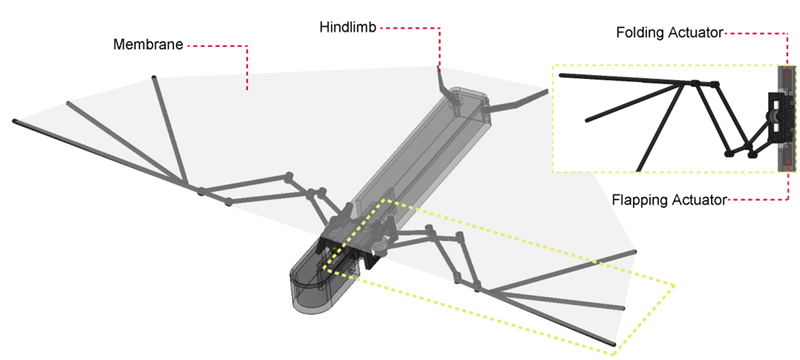Account Login
Don't have an account? Create One

There are a lot of fascinating and possibly commercially-viable ideas sitting behind the doors of university and college laboratories throughout Atlantic Canada. It’s crossed the minds of many people, including Dr. Ting Zou, an assistant professor in mechanical engineering and a specialist in robotics based at Memorial University of Newfoundland and Labrador.
In recent weeks, Zou and doctoral student Tingting Sui have been taking their work on “bat drone” design through the Lab2Market program. The program provides training and support to students and faculty interested in learning more about commercialization and the potential for commercializing the product of their research.
Sui said work within the program to date has involved mentorship but also a long list of cold calls (up to 100) to connect with people she may never have connected with otherwise. Her list includes people working in private industry who might make use of the drone, professionals in government procurement and researchers in both government agencies and industry.
“I think that’s really inspired me,” Sui said, recalling one conversation where she was discussing a few specifics with a possible future customer for bio-inspired drones.
“Before I joined this program I spent most of my time in the lab and dealing with those mechanical parts. Currently I’m talking to a lot of people from different areas, different countries … I feel very grateful and I really appreciate all of this opportunity,” she said.
In the lab
“Though this Lab2Market program is only three months, we still hope that from this program we can get some inspired ideas and some inspiration,” Zou said.
Zou’s research more broadly includes “bio-inspired drones” – a more advanced generation from your typical unmanned aerial vehicles (UAVs). These machines take inspiration from wildlife. They are designed to be capable of more complex movements than the standard hard-plastic quadcopters most people might be familiar with.
There is the bat-inspired drone design worked on with Sui but also, for example, a robotic fish design worked on with a Master of Engineering student. The development of drone designs involves a significant amount of detail, including a need to understand the movements of the real creature you want to replicate, mimic or advance.

To better understand real bats, Zou and Sui teamed up with evolutionary biologist Dan Riskin, an adjunct professor at the University of Toronto whose own research has delved into the physical mechanics of bat flight. If the name is familiar, it may be because Riskin also hosted the television show Daily Planet on Discovery Channel Canada from 2011 until 2018. He regularly writes about science for a general audience and has several books to his credit, including the children’s book, Fiona the Fruit Bat (2022).
Zou and Sui tapped into his work, including data captured while monitoring bats with sensors attached, measuring changes in the joint angles on their wings. The work led to mathematical calculations allowing the engineers to see the key movements for flight and replicate some of the essential movement, allowing a bat-inspired drone design to take shape.
Their drone design includes wings that are not a fixed, hard extension of the body but a branch frame and silicone-based membrane, reminiscent of the structure of a real bat wing. Even the frame is not rigid, with moveable junctions and small motors.
“This robot can not only flap. It can also fold and extend (its) wing at the same time,” Sui said.
In April 2022, the non-profit Institute of Electrical and Electronics Engineers published a paper from the trio (Ting, Sui and Riskin) in the journal IEEE Robotics and Automation Letters titled “Optimum Design of a Novel Bio-Inspired Bat Robot.” Among other things, it describes the “research boom” in recent years related to flying robots and some of the complexities involved more specifically in bat flight. Not all bats and not all bat robots are the same. To that, the paper references some earlier work of other bat and flying robot researchers, such as engineers Alireza Ramezani at Northeastern University, Soon-Jo Chung at the California Institute of Technology (CalTech) and Seth Hutchinson, executive director of the Institute for Robotics and Intelligent Machines at the Georgia Institute of Technology.
At MUN, Sui and Zou’s specific concept is now off the page as a prototype that is still being put through its paces, including upcoming wind tunnel tests, as the engineers work to improve the design. The detailed work has to look at things like lift-to-drag ratio but, essentially, the work is to develop something even more closely matching the advanced capability of the natural bat wing. On the robotics side, one of the challenges would be avoiding adding to the weight.

Lab2Market Experience
While completing their initial work on the design, the researchers naturally talked about the possible applications for the drone. Compared to a traditional off-the-shelf UAV, Sui said, the bat drone is highly maneuverable, uses less energy and emits little noise.
As part of the Lab2Market program, she has become even more excited about the potential for bio-inspired drones, seeing possible early adoption of the bat drone in areas like wildlife monitoring, documentary filmmaking, agricultural crop and land management.
Since it can be flown into an area of interest from a distance, it can be less disruptive than having wildlife researchers or documentarians physically go into an environment to place cameras and other monitoring equipment themselves. “They could personally buy our product to get more accurate monitoring results,” Sui said, stepping into pitch mode (though the drones she’s helped design aren’t for sale just yet). Unlike traditional drones, she said, the low noise level can arguably keep stress on animals to a lower level – something she’s been exploring in conversations with other researchers working with flying drones as well as interested individuals and companies.
“There’s a big possibility for me in future to really work on this, to start a business in this based on my knowledge,” Sui added, saying she better appreciates the hurdles to commercializing a product and developing a viable business, learning more on the regulatory side, and about manufacturing, existing supply chains and from market sounding.
The Lab2Market program awards selected teams $15,000 and supplies training and mentorship. Zou and Sui were part of an Atlantic cohort with training and support run out of Dalhousie University. The cohort includes 19 teams with research as varied as, for example, the investigation of a test to assess the health of honeybee hives (Pascale Michaud and Gilles Robichaud, Université de Moncton), to a technology to help teachers meet the needs of diverse learners in the classroom (Diane Montgomery and Kathy Snow, University of Prince Edward Island). At the same time, to try and meet growing demand for the program, Dalhousie has been working with a second Lab2Market cohort of 15 teams, investigating the potential in projects specifically with a health focus. The work with all 34 teams has been made possible by support from the Government of Canada through the Atlantic Canada Opportunities Agency, Mitacs, Springboard Atlantic, and the Innovation + Impact Network of Canada (I-INC) through the Future Skills Centre.
Comment policy
Comments are moderated to ensure thoughtful and respectful conversations. First and last names will appear with each submission; anonymous comments and pseudonyms will not be permitted.
By submitting a comment, you accept that Atlantic Business Magazine has the right to reproduce and publish that comment in whole or in part, in any manner it chooses. Publication of a comment does not constitute endorsement of that comment. We reserve the right to close comments at any time.
Cancel